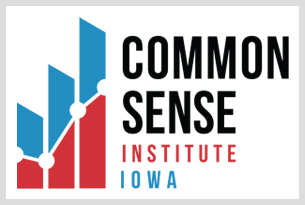Author: Ben Murrey
Introduction
Most of the data discussed in this report come from the U.S. Bureau of Labor Statistics’ Consumer Price Index (CPI) database. This source, however, produces estimates of price levels neither for Iowa exclusively nor for any metropolitan area within Iowa. The report therefore references data from the Midwest region (Illinois, Indiana, Iowa, Kansas, Michigan, Minnesota, Missouri, Nebraska, North Dakota, Ohio, South Dakota, and Wisconsin) as a proxy for inflation in Iowa.
The chart below, inspired by the American Enterprise Institute’s “Chart of the Century,” displays 20 years of changes in wages, inflation, and the prices of consumer goods and services in Iowa since the beginning of the 21st century. Over the last two decades, real wages have risen locally while most durable and nondurable goods have remained affordable. Meanwhile, the rising costs of housing, health care, and higher education have increasingly crowded out more and more of every dollar of spending. Broken into two periods—before the COVID-19 pandemic and after—however, the data paints a different picture.
Prior to the fiscal and monetary stimulus in response to the COVID-19 pandemic, price trends varied by category with bouts of inflation, disinflation, and even deflation for different categories. Since 2020, however, prices have trended upward in all categories. Similarly, while Iowans’ wages rose in real terms between 2002 and 2022, a stark difference appears in the trend from 2002 to 2020 versus the trend since 2020. Prior to the pandemic, Iowans’ wages rose at more than double the rate of inflation—a 78% increase in wages versus a 37% increase in prices. Since 2020, however, Iowans have seen a significant decrease in real wages, as they experienced an 18% increase in prices while their wages rose only 7.5%. Fortunately, wages are recovering with a 10% surge over the last year while inflation has cooled or declined.
While the chart in this report offers no explanation of the reasons behind the variations in price growth between items, we hope it serves as a common starting point and inspires discussion and more informed questions.
Key Insights
- At an increase of over 150% since 2002, the price of 4-year tuition at a public university and the price of gasoline remain dominant over all other items; however, gasoline prices remained highly volatile throughout the period with years of drastic increases and decreases, while the cost of tuition has increased steadily at 2% to 7% annually.
- Apparel, durables, household furnishings, and recreation remain well below total inflation rates. While these have increased in price since 2020, Iowa consumers enjoyed deflation in apparel, durables, and household furnishings from 2002 through 2020.
- Within the last 3 years, 12 of the 14 categories experienced their highest price increases within our captured time frame (2002-2023).
Year-to-Year Changes
- Overall inflation clocked in at 3.8% from 2022 to 2023.
- The price increases in food and beverage, services, recreation, and rent have all outpaced overall inflation over the last year.
- Across all categories, the recent surge of inflation peaked in 2022. The price of gasoline, household energy, and durables all fell from 2022-2023. For all other categories, the rate of increase in prices slowed over the last year relative to the previous year.
- Gasoline, while growing rapidly over the past two years at 68% in 2021 and 46% in 2022, experienced a sharp decrease in price of 13% in 2023.
- After a 10% increase from 2021 to 2022, the increase in home prices over the last year returned closer to the 20-year mean of just below 4%.
- After falling by 4% from 2022 to 2023, Iowans’ average weekly wages grew by 10.5% over the last year.

